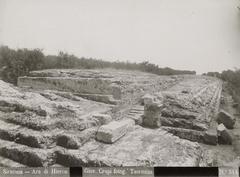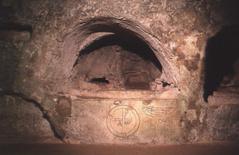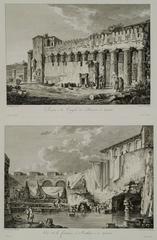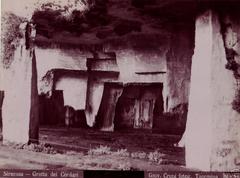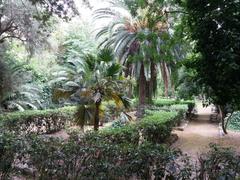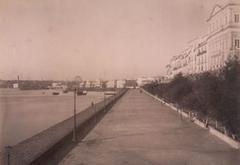Necropolis of Cassibile Visiting Hours, Tickets, and Syracuse Historical Sites Guide
Date: 03/07/2025
Introduction
Nestled in the striking Cavagrande del Cassibile Nature Reserve near Syracuse, Sicily, the Necropolis of Cassibile is a fascinating testament to the island’s ancient past. As one of Sicily’s largest and most significant prehistoric burial sites, Cassibile seamlessly blends profound archaeological importance with breathtaking natural scenery. Carved into limestone cliffs overlooking the dramatic Cassibile River canyon, the site encompasses thousands of rock-cut tombs dating from the Late Bronze Age to the Early Iron Age (circa 1300–700 BCE). It offers visitors a unique opportunity to explore the funerary traditions of the Siculi people—one of Sicily’s indigenous populations—while experiencing the biodiversity of the reserve’s gorges, rivers, and endemic flora and fauna. This comprehensive guide provides detailed visitor information, including opening hours, ticketing, directions, accessibility, and travel tips, alongside insights into the site’s history, archaeological discoveries, and surrounding natural habitats. Whether you are a history enthusiast, nature lover, or curious traveler, the Necropolis of Cassibile is a must-visit destination, offering a memorable journey into Sicily’s protohistoric heritage and Mediterranean cultural exchanges (Life in Italy; Sicily Visitor; Mamma Sicily; Enjoy Sicilia).
Table of Contents
- Introduction
- Origins and Historical Context
- Archaeological Discoveries and Site Highlights
- Cultural and Ritual Significance
- Mediterranean Connections
- Preservation and UNESCO Recognition
- Geographic and Environmental Overview
- Visiting the Necropolis of Cassibile
- Nearby Attractions
- Responsible Tourism and Conservation
- Visuals and Media Recommendations
- Frequently Asked Questions (FAQ)
- Conclusion and Visitor Recommendations
- Sources and Further Reading
Origins and Historical Context
The Necropolis of Cassibile, carved into the steep limestone plateaus and cliffs of the Cassibile River canyon, is attributed primarily to the Siculi, a pre-Roman people who migrated from the Italian mainland. Established between the 13th and 7th centuries BCE, the necropolis marks a pivotal transition from the Bronze Age to the Iron Age in Sicily, reflecting profound shifts in social organization, burial customs, and technological advancements (Life in Italy). Closely related to other major burial sites such as Pantalica, Cassibile forms part of a network of indigenous necropolises in southeastern Sicily, underscoring the region’s role as a crossroads of Mediterranean civilizations.
Archaeological Discoveries and Site Highlights
Systematic excavations, most notably under archaeologist Paolo Orsi in the late 19th and early 20th centuries, revealed a wealth of artifacts—pottery, tools, personal ornaments, and bronze fibulae—many now preserved at the Museo Archeologico Regionale Paolo Orsi in Syracuse (Sicily Visitor). The necropolis features over 2,000 rock-cut tombs, organized into distinct clusters such as those at Cugno Spineta and Monte Maio. Tombs range from simple, single-chambered cavities to elaborate multi-room structures, demonstrating evolving burial rituals and the emergence of social stratification. A standout is the Anaktoron, or “Prince’s Palace,” a monumental megalithic structure atop the plateau, believed to have served ceremonial or administrative functions. Its architecture indicates contact with Mycenaean Greece, reinforcing the site’s links with broader Mediterranean trade and cultural networks (Life in Italy).
Cultural and Ritual Significance
Cassibile reveals intricate funerary rites, with tomb goods such as jewelry, weapons, and ceramics pointing to beliefs in an afterlife and ancestor veneration. The transition from collective to individual burials mirrors the rise of local elites and increasing social complexity during the Late Bronze Age. The burial customs and grave offerings at Cassibile provide vital insights into the spiritual and societal dynamics of pre-Greek Sicilian communities.
Mediterranean Connections
Artifacts and architectural parallels at Cassibile, including the Anaktoron, reveal significant influence from Mycenaean and other Aegean cultures. These connections highlight the site’s involvement in Mediterranean trade and cultural exchanges before the full advent of Greek colonization. Proximity to Syracuse, a major Greek colonial city, further underscores Cassibile’s pivotal role as a meeting point between indigenous Sicilian and external traditions (Great Sicily).
Preservation and UNESCO Recognition
Cassibile is part of the UNESCO World Heritage listing that includes Syracuse and the Rocky Necropolis of Pantalica, recognizing its outstanding universal value as a testimony to ancient Sicilian civilizations (Sicily Visitor). Ongoing archaeological research and conservation initiatives are in place to protect the site from environmental pressures and visitor impact.
Geographic and Environmental Overview
Cavagrande Nature Reserve and Microenvironments
The necropolis is located within the Riserva Naturale Orientata Cavagrande del Cassibile, a protected area spanning approximately 2,700 hectares. The reserve’s dramatic canyon, carved over millennia by the Cassibile River, plunges up to 300 meters deep and stretches for nearly 10 kilometers (Casa Farlisa; Mamma Sicily). The landscape includes riparian zones, rocky terraces, caves, Mediterranean scrub, and the famous “laghetti” or freshwater pools.
Flora and Fauna
Flora: The reserve boasts rich biodiversity, with riparian forests (oriental plane, willow, poplar, oak, ash), Mediterranean maquis, and endemic species such as prickly juniper (Juniperus oxycedrus) and rare Ephedra fragilis. Spring brings a profusion of wildflowers and orchids (Sicilia Italia Guida).
Fauna: The area is home to typical Hyblean mammals (foxes, rabbits, hedgehogs, weasels), numerous bat colonies, and a variety of birds including peregrine falcons, buzzards, and kestrels (Casa Farlisa). The Cassibile River supports river crabs, native trout, eels, frogs, water snakes, and a rich diversity of invertebrates.
Visiting the Necropolis of Cassibile
Opening Hours
- Necropolis and Reserve: Open daily, typically from 9:00 AM to 6:00 PM. Hours may extend during summer, and access may be restricted during high fire-risk periods (usually July–September). Always check current conditions with local authorities or online before visiting.
Tickets and Admission
- Entry: Access to both the necropolis and Cavagrande reserve is generally free. Parking fees apply in private lots near main trailheads.
- Guided Tours: Local organizations and guides offer tours for a fee. These provide valuable archaeological and ecological context and are highly recommended.
Accessibility
- The site’s steep, rugged terrain limits accessibility. Some improved paths exist near main clusters, but most areas—including the descent into the canyon—are not suitable for visitors with mobility impairments.
Guided Tours and Events
- Guided tours and seasonal events (such as archaeological workshops or nature walks) are organized by local organizations. Check the reserve’s official website or local tourism offices for current schedules.
Directions and Transportation
- By Car: The site is best reached by private vehicle. From Syracuse, follow the SS115 towards Avola, then local signs to Cavagrande. GPS coordinates: 36.96599°N, 15.16528°E.
- Parking: Paid parking is available at main trailheads (e.g., Scala Cruci), with free options further away (Backpackers in the World).
- Public Transport: Limited bus services operate from Syracuse; check schedules in advance.
Trailheads and Site Layout
- Scala Cruci Trail: Main and most popular access point, with parking, facilities, and signage. Steep descent (1.8 km, 300 m elevation change) into the canyon.
- Mastra Ronna and Carrubella Trails: Alternative entrances offering shorter or quieter routes but with less infrastructure (Backpackers in the World).
- On Site: The necropolis is organized into 32 main clusters, with tombs carved directly into the cliffs. Panoramic viewpoints offer exceptional photography opportunities, especially early or late in the day.
Facilities and Practical Tips
- Amenities: Bar/restaurant and restrooms at Scala Cruci; limited or no services on trails. Bring water, snacks, sturdy footwear, sun protection, and swimming gear for the pools.
- Best Time to Visit: Spring and autumn for mild weather, wildflowers, and birdlife; early or late in the day for the best lighting and fewer crowds.
- Preparation: The hike back out of the canyon is strenuous; allow sufficient time and bring a map or GPS, as signage is limited.
Nearby Attractions
- Museo Archeologico Regionale Paolo Orsi: Houses artifacts from Cassibile and other major Sicilian sites.
- Syracuse (Ortigia and Neapolis): Explore the UNESCO-listed city, Greek Theatre, and archaeological park.
- Fontane Bianche Beach: Sandy beach for post-hike relaxation.
- Noto: Baroque architecture and Sicilian cuisine (Enjoy Sicilia).
Responsible Tourism and Conservation
Cassibile is part of a protected nature reserve. To help preserve its unique heritage:
- Stay on marked trails.
- Do not disturb wildlife or remove archaeological/natural materials.
- Carry out all rubbish.
- Respect any seasonal closures or restrictions.
- Support local businesses and initiatives.
Visuals and Media Recommendations
Enhance your research or travel planning with:
- High-quality photographs of the tombs, canyon, and laghetti, with descriptive alt text such as “Necropolis of Cassibile rock-cut tombs” and “Cassibile River canyon view.”
- Interactive maps and virtual tours available on official tourism websites.
- Suggested images: panoramic views, close-ups of tomb entrances, and wildlife shots.
Frequently Asked Questions (FAQ)
Q: What are the opening hours for the Necropolis of Cassibile?
A: Open daily, usually 9:00 AM–6:00 PM; check for seasonal variations and restrictions.
Q: Is there an entrance fee?
A: Entry is free; parking fees may apply.
Q: Can I book a guided tour?
A: Yes, through local operators and the reserve’s visitor center.
Q: Is the site suitable for children or people with mobility issues?
A: Due to steep, rugged trails, the site is not recommended for those with mobility challenges or very young children.
Q: Can I swim in the pools?
A: Yes, swimming is permitted in designated areas. Use caution and check water depth.
Conclusion and Visitor Recommendations
The Necropolis of Cassibile is a remarkable destination where archaeology and nature converge. As one of Sicily’s most important prehistoric sites, it offers a profound glimpse into the island’s early societies and their connections across the Mediterranean. The surrounding Cavagrande reserve provides an ideal setting for hiking, wildlife observation, and swimming, making it a rewarding experience for adventurers and history lovers alike. Prepare for challenging terrain, respect conservation guidelines, and consider a guided tour to enrich your understanding. Enhance your experience by downloading the Audiala app for audio tours and up-to-date travel tips, and explore our related guides to uncover more of Sicily’s historical and natural treasures.
